Strauch Fiber Equipment Co.
We Handcraft It All With You In Mind.
Helpful Hints
We don't just make fiber tools, we use them too!
Please contact us if you have more questions. We're happy to help!
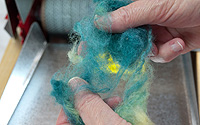
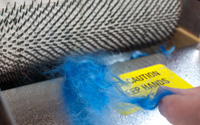
Carding
- Fiber preparation: don't expect your drum carder to take a knotted and almost felted clump of fiber and magically convert it into a beautiful batt. Tease out any clumps and locks so that a loose, fluffy mass is being fed into the carder.
- Don't over feed. Put about a handful of teased fiber on your carder's tray.
- Don't underfeed. If you try to feed one strand at a time--nothing will happen!
- Don't hold back. Most folks have a tendency to hold onto the fiber as it's being carded. This will cause it to wrap around the small drum. Allow the carder to draw in the fiber and pull back just enough so that the entire mass is not gulped into the small drum. Another technique is to "snap back" on the fiber as it's being fed thus not allowing the carder to pull in too much material. This will take practice.
- Feed clean fiber. Wool, especially, needs to be washed prior to carding. The lanolin will coat the drums and makes for a real mess. Make sure your fiber is free of vegetable matter, droppings etc.
- When feeding, keep the fiber one inch away from both ends of the small drum. This will minimize wrapping fiber around the bearings supporting the drum.
- Don't over fill the large drum. Watch carefully; stop feeding fiber if it starts to either
- Clump up on the large drum,
- Or go over the edge of the large drum,
- Or starts wrapping around the infeed drum.
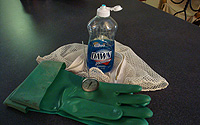
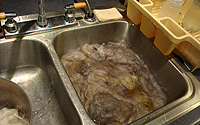
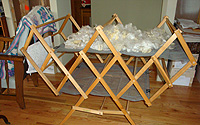
Washing Wool
- Water should be at least 150° to break down the lanolin (grease).
- Put wool into water, layering it with squirts of DAWN. Do not pour the water onto the wool. I do 1 to 1-1/2 lbs at a time in the kitchen sink and put screening or netting in the bottom of the sink to hold the wool. You can also use a net bag.
- Push the wool down in the water & squish the soap through the wool. AVOID AGITATING or RUBBING the wool; it will felt.
- Let it soak, but not so the water cools lower than 130° to 135°.
- Drain the soapy water out of the sink and squeeze the wool inside the screening to remove excess soap.
- Fill the sink with rinse water that is 130°/135° . You can use a liquid fabric softener, this helps remove the soap.
- Put the wool into the rinse water and again, push it down and squish to remove soap.
- Let soak a bit then drain rinse water and gently squeeze the wool in the screening to remove excess water.
- You can roll the wool in a towel to remove excess water or spin in a washing machine without using the water spray.
- Then spread out to dry.
Remember:
AVOID AGITATING & EXTREME CHANGES IN WATER TEMPERATURE....THE WOOL WILL FELT!
Joanne Strauch's hints for washing other fibers:
- Fibers without the lanolin (grease) can be washed in the same manner. But you can use water at a lower temperature. You can use 130 deg water instead of 150 deg.
- A note: I soak mohair for a day in warm, soapy water in a pail prior to washing. This loosens up the dirt, otherwise you have to wash it several times.
Have fun!! Otto & Joanne Strauch